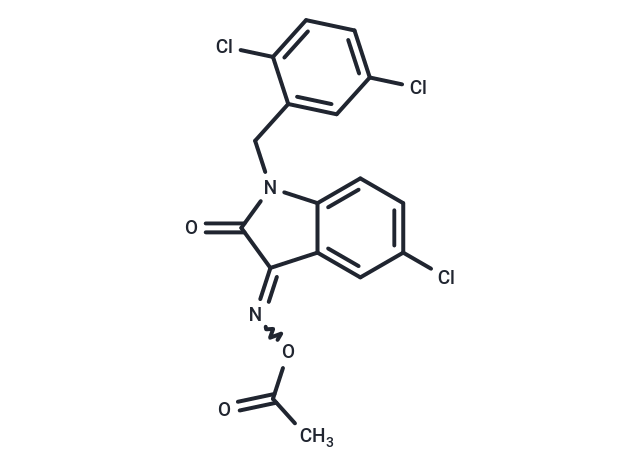Shopping Cart
- Remove All
 Your shopping cart is currently empty
Your shopping cart is currently empty

LDN-57444 is a reversible, competitive inhibitor of the proteasome Uch-L1 with an IC50 of 0.88 μM.

| Pack Size | Price | Availability | Quantity |
|---|---|---|---|
| 2 mg | $34 | In Stock | |
| 5 mg | $51 | In Stock | |
| 10 mg | $92 | In Stock | |
| 25 mg | $176 | In Stock | |
| 50 mg | $313 | In Stock | |
| 100 mg | $486 | In Stock | |
| 1 mL x 10 mM (in DMSO) | $51 | In Stock |
| Description | LDN-57444 is a reversible, competitive inhibitor of the proteasome Uch-L1 with an IC50 of 0.88 μM. |
| Targets&IC50 | UCHL1:0.88 μM |
| In vitro | In vivo, LDN-57444 significantly alters the distribution of synaptic proteins and the morphology of dendritic spines. It leads to a reduction in UCH-L1 activity but does not affect the protease inhibition of cAMP levels. |
| In vivo | LDN-57444 (25-50 μM) reduces cell viability in a dose-dependent manner by inhibiting the activity of the ubiquitin-proteasome system and increasing the levels of highly ubiquitinated proteins, thereby inducing apoptosis. |
| Kinase Assay | HTS screen: To start an assay, 0.5 μL of 5 mg/mL test compound (about 50 μM final reaction concentration) or DMSO control is aliquoted into each well. Both enzyme and substrate are prepared in UCH reaction buffer (50 mM Tris-HCl [pH 7.6], 0.5 mM EDTA, 5 mM DTT, and 0.5 mg/mL ovalbumin). 25 μL of 0.6 nM UCH-L1 is then added to each well except substrate control wells, followed by plate shaking for 45–60 s on an automatic shaker. The enzyme/compound mixture is incubated at room temperature for 30 min before 25 μL of 200 nM Ub-AMC is added to initiate the enzyme reaction. The reaction mixture (300 pM UCH-L1, 100 nM Ubiquitin-AMC with 2.5 μg test compound) is incubated at room temperature for 30 additional minutes prior to quenching the reaction by the addition of 10 μL 500 mM acetic acid per well. The fluorescence emission intensity is measured on a LJL Analyst using a coumarin filter set (ex = 365 nm, em = 450 nm) and is subtracted by the intrinsic compound fluorescence to reveal the enzyme activity. A DMSO control (0.5 μL of DMSO, 25 μL of UCH-L1, 25 μL of ubiquitin-AMC, 10 μL of acetic acid), enzyme control (25 μL of UCH-L1, 25 μL of buffer, 10 μL of acetic acid), substrate control (25 μL of buffer, 25 μL of ubiquitin-AMC, 10 μL of acetic acid), and inhibitor control (0.5 μL of ubiquitin aldehyde [100 nM stock], 25 μL of UCH-L1, 25 μL of ubiquitin-AMC, 10 μL of acetic acid) are also performed in each assay plate to ensure quality and reproducibility. Potential UCH-L1 inhibitors are selected if the compounds demonstrated greater than 60% inhibition compared to the controls. The UCH-L1 enzymatic reactions are manually repeated twice using the same protocol to confirm the results for the hit compounds from the primary robot-assisted screen. |
| Cell Research | MTT assay(Only for Reference) |
| Alias | LDN57444 |
| Molecular Weight | 397.64 |
| Formula | C17H11Cl3N2O3 |
| Cas No. | 668467-91-2 |
| Smiles | CC(=O)ON=C1C(=O)N(Cc2cc(Cl)ccc2Cl)c2ccc(Cl)cc12 |
| Relative Density. | 1.50 g/cm3 (Predicted) |
| Storage | Powder: -20°C for 3 years | In solvent: -80°C for 1 year | Shipping with blue ice. | ||||||||||||||||||||||||||||||
| Solubility Information | DMSO: 19.9 mg/mL (50.05 mM), Sonication is recommended. | ||||||||||||||||||||||||||||||
Solution Preparation Table | |||||||||||||||||||||||||||||||
DMSO
| |||||||||||||||||||||||||||||||

Copyright © 2015-2025 TargetMol Chemicals Inc. All Rights Reserved.